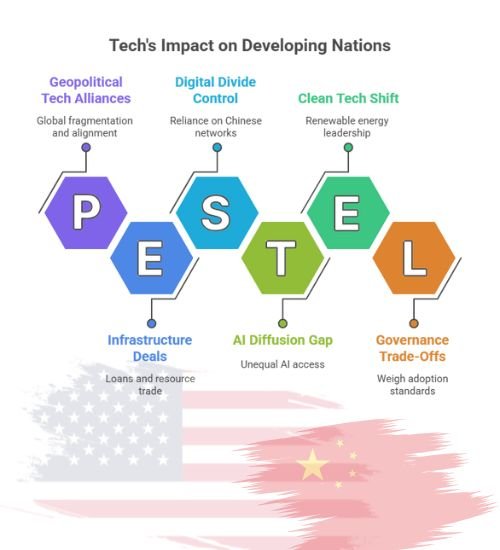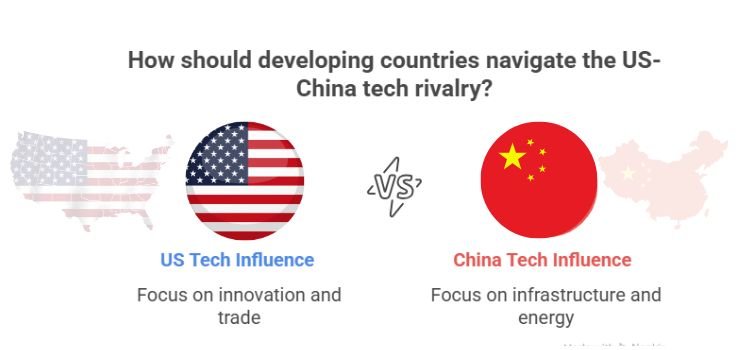Tech conflict between the US and China now shapes global trends. Developing countries feel it most of all. They face trade shifts, infrastructure gaps, and energy pivots. The rivalry in AI, semiconductors, and clean tech echoes in poorer nations. Short sentences. Clear nuance. Natural tone.
“American views swing from overestimation to under-estimation. Rarely get right on Chinese innovation.”
1. Technology Access and Infrastructure
Control of key tech hits developing nations fastest. Global supply chains fracture. New export limits hit semiconductors and 5G gear. This press disrupts access to critical components Modern Diplomacy.
Developing countries saw a sudden tech price hike. Some lost ability to update systems. Nations lean on cheaper Chinese goods. That shift brings risk and reward.
2. AI Diffusion and Skills Gap
AI spreads, but slowly in low-income nations. A 2024 study notes a gap in AI access. Trends show it may narrow soon.
China leads in value-chain AI diffusion. The US leads in research ties and knowledge sharing.
Developing countries must choose. Rely on research from the US. Or on cheaper tools via China. A tough trade-off.
3. Renewable Energy and Clean Tech Shift
China now leads green tech exports. In 2024, 43% of its clean-tech exports went to emerging markets, up from 24% in 2022 Financial Times.
China spends $680 billion on clean-tech manufacturing in 2024—matching combined US and EU investment The Washington Post.
Chinese renewables drop in price. That pulls developing countries in. But raises concerns about dependence
4. Geopolitics and Tech Alliances
Escalating tech rivalry fuels global fragmentation Modern Diplomacy. Developing nations risk being forced into camps. They may lose neutral options.
Some experts call this a “New Cold War.” This shift could force poor countries into foreign alignment Modern Diplomacy.
5. Infrastructure Deals and Diplomacy
China builds ports, railways, and dams across Africa and Asia. Deals often come with loans or resource trade
Such projects bring tech. But lock host countries into China’s orbit. The US offers less—or pulls back in some areas
7. Digital Divide and Bandwidth Control
China outpaces the US in telecom infrastructure. In 2014, it hosted 29% of global telecom capacity—US had 13%
That leaves developing countries reliant on Chinese networks and gear. Makes digital divide worse.
8. Innovation Inequality and Governance Trade-Offs
A 2025 study calls this “The Janus Face of Innovation.” Developing nations face unequal AI access. They must weigh cheaper adoption against weak governance standards .
Need new institutions to manage tech transfer wisely. To close divides. And ensure responsible development.
9. Emerging Growth Models: Beyond Superpower Paths
Time magazine argues neither US nor Chinese growth models suit emerging economies TIME.
It proposes “sovereignty interdependence.” A hybrid model. Build own strength. And still stay global.

Summary Table
| Area | Impact on Developing Countries |
|---|---|
| Tech Access | Supply chain disruptions. Hurt access to semiconductors, 5G. |
| AI Diffusion | China leads supply chain adoption. US leads in research. |
| Clean Tech | Cheaper Chinese renewables. Growing dependence. |
| Geopolitics | Forced alignments. Loss of neutrality. |
| Infrastructure | Chinese-led projects with debt strings. |
| Digital Divide | Chinese control of bandwidth deepens inequalities. |
| Innovation & Governance | Trade-offs between access and oversight. Need new frameworks. |
| Growth Models | Calls for hybrid path beyond US or Chinese systems. |
FAQs
-
What is the US-China tech rivalry?
The race for dominance in AI, semiconductors, clean tech, and infrastructure. It splits global economies and supply chains. -
How does this rivalry affect developing countries?
Countries face limited tech access, debts from infrastructure deals, reliance on Chinese clean energy, and forced geopolitical choices. -
Why do countries rely on China’s clean tech?
China’s mass production cuts costs. In 2024, emerging markets received 43% of China’s clean-tech exports. -
Are AI tools accessible in low-income nations?
Access is limited. China spreads AI through cheap hardware and value chains. The US leads in research and transfer. -
Is neutrality possible for developing nations?
Difficult. Rivalry pushes countries toward alignment. A hybrid “sovereignty interdependence” model may help TIME. -
Can developing countries build digital independence?
Only with new global governance, fair tech transfer, and balanced infrastructure strategies.
Conclusion
Tech war. Shaping futures. Developing countries stuck in the middle. Choices made now. Last for generations. Need wise paths. Not forced alignments. More voice. More agency. A hybrid, fairer path.

